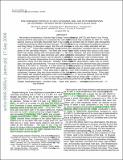Disk-dominated States of 4U 1957+11: Chandra, XMM-Newton, and RXTE Observations of Ostensibly the Most Rapidly Spinning Galactic Black Hole
Author(s)
Nowak, Michael A.; Juett, Adrienne M.; Homan, Jeroen; Yao, Yangsen; Wilms, Jorn; Schulz, Norbert S.; Canizares, Claude R.; ... Show more Show less
DownloadCanizares-Disk-dominated states.pdf (1.653Mb)
PUBLISHER_POLICY
Publisher Policy
Article is made available in accordance with the publisher's policy and may be subject to US copyright law. Please refer to the publisher's site for terms of use.
Terms of use
Metadata
Show full item recordAbstract
We present simultaneous Chandra High-Energy Transmission Gratings (HETG) and Rossi X-ray Timing Explorer (RXTE) observations of a "soft state" of the black hole candidate 4U 1957+11. These spectra, having limited hard X-ray excess, are an excellent test of disk atmosphere models that include effects of black hole spin. The HETG data show, by modeling the broadband continuum and direct fitting of absorption edges, that the disk spectrum is only very mildly absorbed, with N[subscript H] = (1–2) × 10[superscript 21] cm−[superscript 2]. These data additionally reveal λλ13.449 Ne IX absorption consistent with the warm/hot phase of the interstellar medium. The fitted disk model implies an inclined disk around a low-mass black hole rotating with normalized spin a* ≈ 1. We show, however, that pure Schwarzschild models describe the data extremely well, albeit with large disk atmosphere ``color-correction'' factors. Standard correction factors can be attained if one incorporates mild Comptonization. We find that the Chandra observations do not uniquely determine spin, even with this otherwise extremely well-measured, nearly pure disk spectrum. XMM-Newton RXTE observations, taken only six weeks later, are equally unconstraining. This lack of constraint is partly driven by the unknown mass and distance of 4U 1957+11; however, it is also driven by the limited Chandra and XMM-Newton bandpasses. We therefore present a series of 48 RXTE observations taken at different brightness/hardness levels. These data prefer a spin of a* ≈ 1, even when including a mild Comptonization component; however, they also show evolution of the color-correction factors. If the rapid-spin models with standard correction factors are to be believed, then the RXTE observations predict that 4U 1957+11 can range from a 3 M[sun] black hole at 10 kpc with a* ≈ 0.83 to a 16 M[sun] black hole at 22 kpc with a* ≈ 1.
Date issued
2008-12Department
MIT Kavli Institute for Astrophysics and Space ResearchJournal
Astrophysical Journal
Publisher
IOP Publishing
Citation
Nowak, Michael A. et al. “Disk‐dominated States of 4U 1957+11: Chandra,XMM‐Newton,and RXTE Observations of Ostensibly the Most Rapidly Spinning Galactic Black Hole.” The Astrophysical Journal 689.2 (2008): 1199–1214.
Version: Author's final manuscript
ISSN
0004-637X
1538-4357